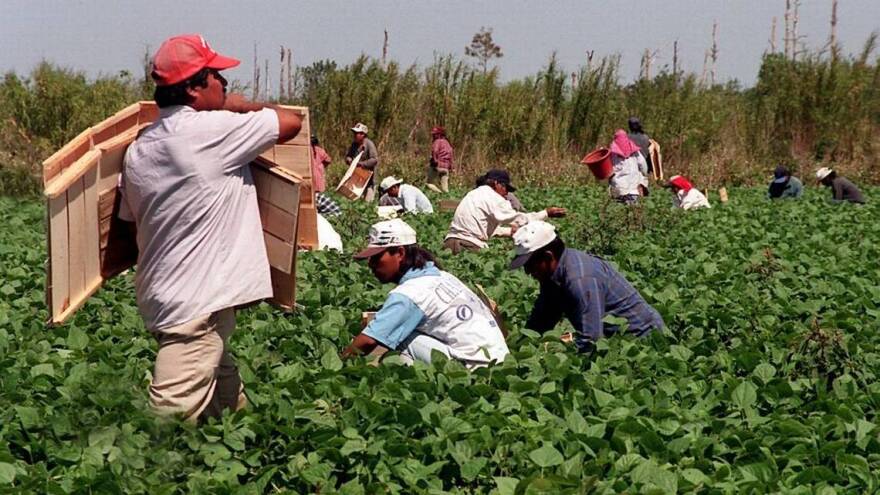Second only to California, Florida stands out as one of the top producers of agricultural products in the nation. Nestled within that is South Miami-Dade, an area that has been critical to the industry — thanks in particular to its migrant farm worker community.
But despite the decades-long role in the region's development, that community's legacy is often lost to time as historical preservation of landmarks skews towards the likes of Art Deco buildings and architecturally-significant sites linked to the region's earliest pioneers.
Now a two-year study is looking to change that. The project will examine the people and places that make up Miami-Dade County's migrant farmworker communities — and their historical significance to the region.
The study will be conducted by the county’s Historic Preservation Board, funded by the National Park Service and the Department of the Interior.
“Miami-Dade is approximately 70% Hispanic or Latino, but only 1% of the county-designated historic sites are associated with Hispanic or Latino heritage,” Sarah Cody, Miami-Dade County’s Historic Preservation Chief, told WLRN.
That’s just within the county — nationally, there are around 95,000 historic places on the National Register, but only 8% are associated with racial or ethnic minorities or women.
It’s hard for the few and fading tangible remains of the farmworker community to compete with the rest of the county’s well-preserved and well-documented architectural sites.
“Very rarely do those stories ever include the many, many people who work every day to operate those farms and make them successful,” said Cody.
Read more: Miami-Dade’s push to protect outdoor workers dies after state ban. What’s next?
In Miami-Dade County, nearly 60% of county-designated historic sites — some of which are also listed nationally — are marked for their architectural significance. That includes poet Robert Frost’s 1940s winter home that he called ’Pencil Pines,’ near South Miami; and the Vanderbilt Estate on Fisher Island. Miami's Freedom Tower is among those on the national registry.
“The goal is to identify as many places as possible that might be eligible for listing and to provide a very thoroughly researched historic context narrative,” added Cody. “But in order to accomplish this, the study is going to really rely heavily on community engagement – it's critical that we hear directly from community members.”
At the end of the study, at least one site associated with the county’s migrant farmworker community will be nominated to the national register of historic places.
Lacking in records
The migrant farmworker community in Miami-Dade has played a significant role in the development of Miami-Dade county, but there is a lack of records about their work and presence in the area.
Cody described how Miami-Dade started with agriculture, following the railroads south. The subtropical climate is ideal for a wide variety of produce, from staples like citrus to more exotic items.
And for decades now, the industry has benefited from the work of immigrants, who since the 1960s have also left their mark in fair labor practices.
“Organized Migrants in Community Action, or OMICA, formed down in Homestead in 1967,” said Cody. “It led to the creation of Centro Campesino, or Farm Workers Center, which has really focused on advocating for fair labor practices and fair living conditions for farm workers.”
Recently, some of those organizations suffered a blow after state law blocked efforts by the county to offer heat protections for migrant workers, while national regulations from Occupational Safety and Health Administration are still in the works.
These current challenges come on top of historical exclusion and lack of resources, which mean tangible remains of the past are often non-existent.
“Many of the resources that have been built for this community over the years, like housing, were really substandard — they were not built to be permanent, they no longer exist today,” Cody said. “We're also today seeing a rapid change in our built environment, a tremendous loss of agricultural lands.”
These issues have given Cody and her team a sense of urgency in their work, as they talk to community members and grassroots organizations like Farm Workers Association of Florida and WeCount! to account for the rich history of migrant farmworkers in Miami-Dade.
In fact, they already have one potential nomination site in mind.
“It's a property down in Florida City, which historically was known as the Cuchiella House,” Cody said. “It's an oolitic limestone structure that has served as part of the offices of the Coalition of Florida Farmworker Organizations for about 30 years.”
The Cuchiella House is already on Miami-Dade’s historic properties list, and a nomination could put it on the national list.
Florida’s history often includes the big names and pioneers of the early 20th century, but by March 2026, Cody hopes that that history will more fully reflect the whole history of Miami-Dade.
“The study that we're going to undertake now is really going to provide an important context for us to understand the significance of the migrant farm worker community," she said. “And ultimately, we can use this project to help make that community more resilient.”










